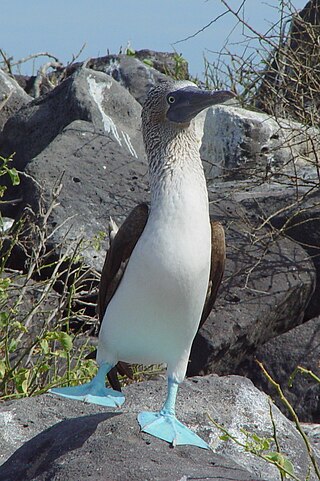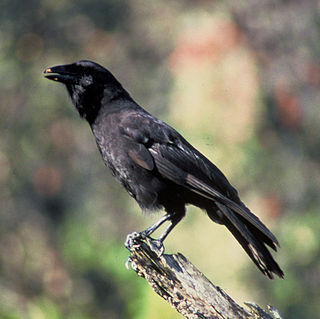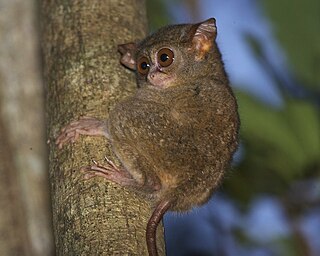
Mackerel is a common name applied to a number of different species of pelagic fish, mostly from the family Scombridae. They are found in both temperate and tropical seas, mostly living along the coast or offshore in the oceanic environment.

Herring are forage fish, mostly belonging to the family of Clupeidae.

A booby is a seabird in the genus Sula, part of the family Sulidae. Boobies are closely related to the gannets (Morus), which were formerly included in Sula.

Sardine and pilchard are common names for various species of small, oily forage fish in the herring suborder Clupeoidei. The term 'sardine' was first used in English during the early 15th century; a somewhat dubious etymology says it comes from the Italian island of Sardinia, around which sardines were once supposedly abundant.

Iglica is a needle-like monument in Wrocław, Poland. It was built in 1948 and was 106 metres tall. Today, after renovation, the top ten metres have been removed and it is now 90 metres tall.

A species that is extinct in the wild (EW) is one that has been categorized by the International Union for Conservation of Nature as only consisting of living members kept in captivity or as a naturalized population outside its historic range. Classification requires exhaustive surveys conducted within the species' known habitat with consideration given to seasonality, time of day, and life cycle. Once a species is classified as EW, the only way for it to be downgraded is through reintroduction.
Iglica gratulabunda is a species of very small freshwater snail with a gill and an operculum, an aquatic gastropod mollusc in the family Moitessieriidae. This species is endemic to Austria. It is probably found in subterranean freshwater habitat, but is known only from floodline debris.

Tarsius is a genus of tarsiers, small primates native to islands of Southeast Asia. Until 2010, all tarsier species were typically assigned to this genus, but a revision of the family Tarsiidae restored the generic status of Cephalopachus and created a new genus Carlito.

Moitessieriidae is a family of small freshwater snails, aquatic gastropod molluscs in the superfamily Truncatelloidea.

Iglica is a genus of very small freshwater snails with an operculum, aquatic gastropod molluscs in the family Moitessieriidae.

The World's 25 Most Endangered Primates is a list of highly endangered primate species selected and published by the International Union for Conservation of Nature (IUCN) Species Survival Commission (SSC) Primate Specialist Group (PSG), the International Primatological Society (IPS), Global Wildlife Conservation (GWC), and Bristol Zoological Society (BZS). The IUCN/SSC PSG worked with Conservation International (CI) to start the list in 2000, but in 2002, during the 19th Congress of the International Primatological Society, primatologists reviewed and debated the list, resulting in the 2002–2004 revision and the endorsement of the IPS. The publication was a joint project between the three conservation organizations until the 2012–2014 list when BZS was added as a publisher. The 2018–2020 list was the first time Conservation International was not among the publishers, replaced instead by GWC. The list has been revised every two years following the biannual Congress of the IPS. Starting with the 2004–2006 report, the title changed to "Primates in Peril: The World's 25 Most Endangered Primates". That same year, the list began to provide information about each species, including their conservation status and the threats they face in the wild. The species text is written in collaboration with experts from the field, with 60 people contributing to the 2006–2008 report and 85 people contributing to the 2008–2010 report. The 2004–2006 and 2006–2008 reports were published in the IUCN/SSC PSG journal Primate Conservation,, since then they have been published as independent publications.

Iglica soussensis is a species of aquatic subterranean gastropod endemic to wells in the Souss Plain, Morocco. I. soussensis is only known from the type locality, a well in the Ait Msia village in the area of Agadir, or described by the IUCN as 'a well at Tamait Izder south of the Souss River north of Temsia, Morocco'. This species is a stygobiont, being restricted to aquatic subterranean habitats









